|
|
 |
|
Calanoida ( Order ) |
|
|
|
Clausocalanoidea ( Superfamily ) |
|
|
|
Scolecitrichidae ( Family ) |
|
|
|
Pseudoamallothrix ( Genus ) |
|
|
| |
Pseudoamallothrix emarginata (Farran, 1905) (F,M) | |
| | | | | | | Syn.: | Scolecithrix emarginata Farran, 1905 (p.36, Descr.F, figs.F); 1926 (p.264); Hardy & Gunther, 1935 (1936) (p.164, Rem.); Park & Ferrari, 2009 (p.143, Appendix 1);
Scolecithrix obtusifrons : Farran, 1908 b (p.54); Hardy & Gunther, 1935 (p.164);
Scaphocalanus obtusifrons With, 1915 (p.194, figs.F,M); Sars, 1925 (part., p.180, Descr.M, figs.M);
Scolecithricella (A.) emarginata : Sewell, 1948 (p.530);
Scolecithricella obtusifrons : A. Scott, 1909 (p.92, figs.F);
Scolecithricella emarginata : Tanaka, 1962 (p.66, figs.F,M, Rem.); Park, 1970 (p.476); Minoda, 1971 (p.29); 1972 (p.326); Roe, 1972 (p.277, tabl.1, tabl.2); 1972 b (p.537); Park, 1980 (p.61, Rem., figs.F); Vives, 1982 (p.292); Gardner & Szabo, 1982 (p.300, figs.F,M); Roe, 1984 (p.357); Guangshan & Honglin, 1984 (p.118, tab.); Hopkins, 1985 (p.197, Table 1, gut contents); Hopkins & Torres, 1988 (tab.1); Wiebe & al., 1988 (tab.7); Shih & Young, 1995 (p.73); Chihara & Murano, 1997 (p.901, Pl.174,175: F,M); Suarez-Morales & Gasca, 1998 a (p.111); Lo & al., 2001 (1139, tab.I); Hernandez-Trujillo & Esqueda-Escargera, 2002 (in Appendix); Dur & al., 2007 (p.197, Table IV); Schnack-Schiel & al., 2008 (p.1046: Tab.2); Galbraith, 2009 (pers. comm.); Park & Ferrari, 2009 (p.143, Table 4, 7: common deep water species, fig.1, Appendix 1, biogeography);
Scolecithrix polaris Wolfenden, 1911 (p.252, figs.F, no M); Farran, 1929 (p.208, 243, figs.F, Rem.); Hardy & Gunther, 1935 (1936) (p.163, Rem.);
Amallothrix obtusifrons : Sars, 1925 (part., p.180, fig.M, no F); Rose, 1933 a (part., p.153, fig.M, no F);
Scolecithricella (Amallothrix) polaris : Vervoort, 1957 (p.106, Rem.); Björnberg, 1973 (p.332);
Amallothrix polaris : Björnberg, 1973 (p. 384); Séret, 1979 (p.118, figs.F, Rem.);
Scolecithricella (Amallothrix) emarginata : Vervoort, 1965 (p.67, Rem.); Björnberg, 1973 (p.332);
? Scolecithrix inornata Esterly, 1906 a (p.67, figs.F);
Amallothrix inornata : Morioka, 1972 a (p.314); ? Davis, 1949 (p.44, figs.F); ? Brodsky, 1950 (1967) (p.260, figs.F,M, Rem.);
? Scolecithrix aequalis Wolfenden, 1911 (p.255, Descr.F, figs.F);
Amallothrix emarginata : Sars, 1925 (p.181, figs.F); Rose, 1929 (p.27); Sewell, 1929 (p.216, 221, Rem.); Rose, 1933 a (p.154, figs.F); Jespersen, 1934 (p.90); 1940 (p.38); Sewell, 1947 (p.154, 158, figs.F, Rem.); 1948 (p.330, 502, 514, 521, 525, 546, 549, 557, 567); C.B. Wilson, 1950 (p.160, fig.F); Grice, 1963 a (p.495); Unterüberbacher, 1964 (p.25); De Decker & Mombeck, 1964 (p.11); Owre & Foyo, 1967 (p.68, figs.F,M); Grice & Hulsemann, 1965 (p.223); 1967 (p.16); Morris, 1970 (p.2301); Björnberg, 1973 (p.384); Bradford, 1973 (p.143); Harding, 1974 (p.141, tab.2, gut contents); Deevey & Brooks, 1977 (p.256, tab.2, Station "S"); Carter, 1977 (1978) (p.35); Vives, 1982 (p.292); Bradford & al., 1983 (p.78, 82, figs.F,M, Rem.); Tremblay & Anderson, 1984 (p.6, Rem.); Lozano Soldevilla & al., 1988 (p.58); Bradford-Grieve & al., 1999 (p.881, 931, figs.F,M); Razouls & al., 2000 (p.343, tab. 5, Appendix); Holmes, 2001 (p.57); Sameoto & al., 2002 (p.12); Vives & Shmeleva, 2007 (p.724, figs.F,M, Rem.); Gaard & al., 2008 (p.59, Table 1, N Mid-Atlantic Ridge); Hidalgo & al., 2010 (p.2089, Table 2) | | | | Ref.: | | | Vyshkvartzeva, 1999 (2000) (p.228, Rem..) |  issued from : O. Tanaka in Publ. Seto Mar. Biol. Lab., 1962, X (1). [p.67, Fig.142]. As Scolecithricella emarginata. Female (from Izu region): a, habitus (dorsal); b, forehead (left lateral side); c, last thoracic segment and urosome (left lateral side); d, rostrum (dorsal view); e, Mxp; f, P1; g, P2; h, P5; i, P5 (abnormal); Male (from Suruga Bay): j, habitus (dorsal); k, forehead (left lateral side); l, last thoracic segment and urosome (left lateral side); m, rostrum (left lateral view); n, Mx1; o, Mx2.
Nota Female: - Cephalothorax about 4.67 times the abdomen length. - Head and 1st pediger segment fused, 4th and 5th pediger segments fused, but line of separation observed in lateral view. - Posterolateral corners of the last thoracic segment rounded, but emarginate in lateral view. - Rostrum composed of a rather small basal to which 2 robust filaments attached, filaments gradually attenuate and notched at apex. - Abdominal segments and caudal rami in the proportional lengths 43 : 21 : 17 : 2 : 17 = 100. - Genital segment slightly swollen ventrally. - Caudal rami about as long as wide. - A1 23-segmented on the left; 22-segmented on the right. They exceed the end of the abdomen by terminal one segment. - A2 exopod 1.2 times as long as endopod. - Mx1 with 9 setae on the outer lobe; 8 setae on exopod; 7 setae on endopod; 4 setae on the 2nd basal; - Mx2 similar to Amallothrix gracilis (Sars , 1925). - Mxp with slender 2nd basal segment and endopod; 2nd endopodal segment as long as the following 2 segments together. - P1 has the 1st exopodal segment with 1 outer edge spine which is slightly longer than half the length of the outer margin of the 2nd segment; coxa with a slight notch on outer distal margin. - P2 with the outer edge spine of the 1s spine which is 2 times as long as the terminal spinet exopodal segment short and straight, not attaining to the proximal 1/3 of the outer margin of the 2nd exopodal segment; coxa with a notch on the distal 1/3 of outer margin; terminal spine of exopod finely serrated, and with about 60 teeth. - Posterior surface of P4 densely covered with groups of minute spines on the segments of exopod and endopod. - P5 has 1 free segment attached to the basal. Terminal segment with 1 inner marginal which is 2 times as long as the terminal spine. Terminal spine set closely to the inner marginal spine. Remarks: P5 shows a considerable degree of variation, sometimes with an abnormal pair of legs which has a rudimentary endopod (fig.i); another specimen had a pair of legs having 2 more spines on the outer margin, one on the opposite of the inner marginal spine, and the another at the base of the terminal spine.
Nota Male: - Abdomen contained 2.6-2.7 times in the length of cephalothorax. - Last two thoracic segments fused, line of fusion seen along the postero-lateral margin. - Podterior magin of the last thoracic segment slightly emarginate. - Rostrum as in female, but the basal part ptoduced ventrally, the filament with a small pointed process near the distal end; apex of the filament deeply notched. - Abdomen 5-segmented; segments and caudal rami in the proportional lengths 16 : 24 : 19 : 29 : 5 : 7 = 100. - Caudal rami divergent, about as long as wide. - A1 20-segmented on left side, 19-segmented on right side. -A2 exopod slightly longer than endopod (30 : 26). - Md with a robust 2nd basal segment; exopod slightly longer than endopod (10 : 9). - Mx1 as in female [except the reduction of the 1st and 2nd inner lobe]. - Mx2 reduced, the setae on the segments of the endopod slender. - Mxp with basal segments of equal lengths. - P1 coxa smooth on the outer margin; outer edge spine on the 1st and 2nd exopodal segments short. - P2 with a slight notch on the distal 1/3 of the outer margin of the 1st basal segment; outer edge spine of the 1st exopodal segment short and straight, about 1/3 the length of the outer margin of the 2nd segment. Terminal spine of exopod with 50 teeth. The arrangement of spinules on posterior surface of the 2nd exopodal segment as in female, and differs from that figured by Sars (1924, Pl. 50, fig.20, as Scolecithrix emarginata) : the 2nd row of spinules are more in number(, whereas in Sars' figure the 2nd row is composed of only 2 large spinules. - P3 and P4 with each 39 and 35 teeth on the terminal spine of exopod. - P5 resembles that of Amallothrix obtusifrons Sars. The segments are all slender. Distal segments of the right leg and the endopod of the left leg missing. Exopod of left leg more slender than that of A. obtusifrons.
|
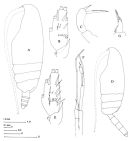 Issued from : J.M. Bradford, L. Haakonssen & J.B. Jillett in Mem. N.Z. oceanogr. Inst., 1983, 90. [p.83, Fig.46]. As Amallothrix emarginata. Female: A, habitus (lateral left side); B, endopod of P2; C, P5. Male: D, habitus (lateral left side); E, endopod of P2; F, P5; G, terminal part of left P5 exopod.
|
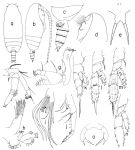 issued from : T. Park in Antarct. Res. Ser. Washington, 1980, 31 (2). [p.63, Fig.19]. As Scolecithricella emarginata. Female: a, habitus (dorsal); b, idem (lateral right side); c, last thoracic segments and urosome (lateral left side); d, forehead (lateral); e, rostrum (anterior); f, A2; g, Md; h, Mx1; i, distal part of Mx2; j, Mxp; k, P1 (anterior); l, P2 (posterior); m, P3 (posterior); n, P4 (posterior); o, P5 (posterior).
|
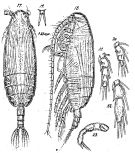 Issued from : G.O. Sars in Résult. Camp. Scient. Prince Albert I, 69, pls.1-127 (1924). [Pl.L, figs.17-23]. As Scolecithrix emarginata. Female (from NE Atlantic): 17, habitus (dorsal); 18, idem (lateral left side); 19, rostrum; 20, endopodal segments of P2; 21, endopodal segments of P3; 22, endopodal segments of P4; 23, P5 (with intercoxal plate). Nota : - Rostrum less thich than in Amallothrix obtusifrons but the same structure. - Posterolateral corners of the last thoracic segment obtusely rounded at end and marked above by an emargination on the posteror margin in lateral view. - Urosome reaching about 1/4 length of the prosome. - Genital segment about as long as than the two following segments together, slightly swollen ventrally before middle - A1 extends back to the caudal rami. - A2, mouthparts and swimming legs of the same structure than in A. obtusifrons, except the number reduction of spinules on posterior surfaces of rami of swimming legs. - P5 with the distal segment not ending in conical point, but obtuse and carrying only 2 spines, the outer margin naked The two spines close up and curved inwards, the inne spine the strongest, whereas reacing barely the length of segment.
|
 Issued from : G.O. Sars in Résult. Camp. Scient. Prince Albert I, 69, pls.1-127 (1924). [Pl.L, figs.15-16]. As Scolecithrix obtusifrons. Male: 15, habitus (dorsal); 16, P5. Nota Male: - P5 extend barely at the extremity of abdomen. The two legs very slender, the right more longer than the left. The left leg has two basal segments very long, the distal with near the base inside a little thoothing protrusion; the exopod is slightly shorter the 2nd basal segment and 3-segmented, the distal very little and hairy inside; endopod rod-shape narrow and simple, passing beyond the exopod. The exopod of the right leg very narrow, 3-segmented with a styliform claw.
|
 issued from : R.B.S. Sewell in The John Murray Expedition, 1933-34, Scientific Reports, VIII (1), 1947. [p.159, Fig.42]. As Amallothrix emarginata. Female (from Central part of Arabian Sea): A, Md; B, Mx1; C, Mx2; D, basal region and endopod of P2; E, basal region and endopod of P3; F, P5. Nota: The 4th and 5th thoracic segment partially separated by a narrow strip along the posterior margin. In the abdomen the proportional lengths of the segments as 38:22:22:8:10.A1 differs on the two sides, right 22-segmented, left 23-segmented; In A2 the 1st basal segment bears a row of long hairs on its inner border; the 1st exopodal segment is produced in a small rounded prominence on its anterior margin near the distal border. Md is a powerful biting organ; the two rami of the palp are approximately equal length. Mx2 and Mxp agree with the figures given by Farran, except the 2 nd basal segment of the Mxp bears a sensory appendage (agreeing with With's specimen). The number of setae from the various parts of Mx1: outer lobe (9); inner lobe 1 (12), inner lobe 2 (2), inner lobe 3 (4); basal segment 2 (4); endopod (7); exopod (9).
|
 Issued from : K.A. Brodskii in Calanoida of the Far Eastern Seas and Polar Basin of the USSR. Opred. Fauna SSSR, 1950, 35 (Israel Program for Scientific Translations, Jerusalem, 1967) [p.260, Fig.168]. As Amallothrix inornata. Wth doubt. Female (from NW Pacif.): habitus (dorsal and lateral left side); R, rostrum; S1, P1; S5, P5. Male: habitus (lateral left side); S5, P5.
|
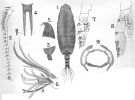 issued from : A. Scott in Siboga-Expedition, 1909, XIX a. [Plate XXXI, Figs.1-9]. As Scolecithricella obtusifrons. Female (from Molucca Passage, Halmahera Sea, Manipa Srrait): 1, habitus (dorsal); 2, forehead (lateral); 3, last thoracic and genital segments (left side); 4, rostrum; 5, A1; 6, Mx2 (distal portion); 7, P2; 8, P4; 9, P5.
|
 issued from : G.P. Farran in Ann. Rep. Fish. Brch., Ireland, 1902-1903, II, App. 2, 1905. [Plate VII, Figs.6-13]. As Scolecithrix emarginataFemale (from W ireland): 6-7, habitus (lateral and dorsal, respectively); 8, rostrum (ventral); 9, A1; 10, A2; 11, Mx1; 12, Mx2; 13, Mxp.
|
 issued from : G.P. Farran in Ann. Rep. Fish. Brch., Ireland, 1902-1903, II, App. 2, 1905. [Plate VII, Figs.14-17]. As Scolecithrix emarginataFemale: 14-16, P1 to P3; 17, P5.
|
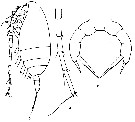 issued from : R.N. Wolfenden in Die Marinen Copepoden der Deutschen Südpolar-Expedition 1901-1903, 1911. [p.252, Fig.31, b, c, d]. As Scolecithrix polaris. Female (from Antarctic Continent): b, habitus (lateral); c, terminal segments of A1; e, P5.
|
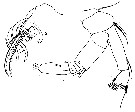 issued from : R.N. Wolfenden in Die Marinen Copepoden der Deutschen Südpolar-Expedition 1901-1903, 1911. [Pl.XXX, Figs.1-2]. As Scolecithrix polaris. Female: 1, A2; 2, distal part of Mx1.
|
 issued from : C.C. Davis in Univ. Wash. Publs Biol., 1949, 14. [Pl.7, Figs.90-91]. As Amallothrix inornata With doubt. Female (from NE Pacific): 90, habitus (lateral); 91, P5. Nota : Head without crest. Head and 1st thoracic segment fused. Lateral corners of the 5th thoracic segment rounded, with an indentation near the upper edge, and another smaller one below. Urosome 1/5 the length of metasome, and consists of 4 segments. Genital segment nearly as long as the next two together, while the 2nd segment is slightly longer than the 3rd ; anal segment , when the animal is viewed from side, is visible ventrally , very short (dorsally completely telescoped into the 3rd segment). A1 23-segmented, reach slightly beyond the caudal rami. 1st exopod segment of P1 with an outer border spine. P5 2-segmented, the terminal segment bears 2 spines ; there is a short apical spine and a longer spine fairly near it subterminally on the inner border ; both spines are provided with fine hairs. For Davis, this species is very close to Scolecithrix emarginata Farran (1905). The anal segment of A. inornata is much shorter than that of A. emarginata, and the exact arrangement of the spines on the posterior surface of P2 to P4 is different. The armature of the posterior surface of the endopod of P3 agrees closely with that part which is labelled as the P4 in Esterly’s figure, whereas both disgree in many details with the armature of emarginata as drawn by Sars (1925). For Davis inornata should be considered as a subspecies of emarginata, but it seems better to maintain Esterly’s species.
|
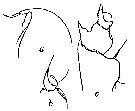 issued from : C. With in The Danish Ingolf-Expedition, Copepoda I, 1915, III, 4. [p.195, Text-fig. 60]. As Scaphocalanus obtusifrons. Female (from 57°47'N, 11°33'W): a, forehead (lateral); b, basis of left P2 (anterior view); basis of left P4 (anterior view). Nota: P2 with the outer marginal tooth of the basis well developed, and the inner margin is near the tip produced into a short curved tooth. The terminal seta has about 70 partly fused teeth without the characteristic basal fenestra. Glandular pores seem to be present in exopodal segments 2 and 3. P4 with basis very clumsy without marginal bristles, and suddently restricted near the tip; on the posterior syrface transversely placed short spines were observed in endopodal segment 2, and in a less degree in endopodal segment 3, but the anterior surface is covered all over with areas of more or less delicate teeth; the serration of the terminal setae are more or less fused in the middle; a glandular pore is observed not only in exopodal segments 2 and 3, but in exopodal segment 1 as well.
|
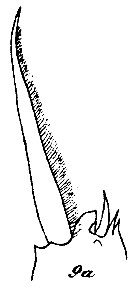 issued from : C. With in The Danish Ingolf-Expedition, Copepoda I, 1915, III, 4. [p.257, Pl. VII, fig. 9a]. As Scaphocalanus obtusifrons. Female: 9a, terminal seta of right P4.
|
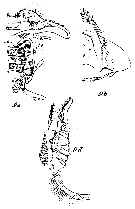 issued from : C. With in The Danish Ingolf-Expedition, Copepoda I, 1915, III, 4. [p.257, Pl. VII, 9b-d]. As Scaphocalanus obtusifrons. Female: 9b, labrum (anterior view); 9c, same (oral view); 9d, serrula 6-dentata. Nota : In the anterior portion of the labrum, the anterior curved group of long delicate setae is posteriorly on each side divided into an outer and inner portion ; i, the middle an anteriorly convex row is found ; for further details see the figure. The oral surface of the labrum (fig.9c) shows a rather characteristic structure, bearing most resemblance to that of Scottocalanus ; the first oblique group of the longitudinal series is smaller than in Scaphocalanus magnus, and it is followed by two or three more or less fused groups of fairly long setae, between which the transverse median rows are placed, behind the mentioned groups an oblique one of more slender hairs, corresponding to the square one of Scaphocalanus magnus is found. Laterally, in front, two groups of delicate hairs are found. No distinct lamina labialis was observed ; in front of the serrula 6-dentata an inner and an outer longitudinal series where found (fig.9d) ; the arrangement of hairs between and behind the serrulae was not studied in details. In the middle, between the labial lobes, a large median group of setae was found, which on each lobe is continued into two lateral series placed closely to each other ; more laterally, well separated from this system, a lateral row of shorter setae, starting from a basal group. The intestinal tract is anteriorly produced into a rather slender rostral coecal sac ; posteriorly the wide stomach is attenuated, an dis, somewhat in front of the abdomen, continued through a slight curvature into the straight intestine proper.
|
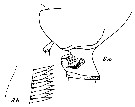 issued from : C. With in The Danish Ingolf-Expedition, Copepoda I, 1915, III, 4. [p.259, Pl. VIII, 8a, 8b]. As Scaphocalanus obtusifrons. Female: 8a, last thoracic segment with P5 and genital segment (left lateral); 8b, median portion of the terminal seta of P5.
|
 issued from : C. With in The Danish Ingolf-Expedition, Copepoda I, 1915, III, 4. [p.259, Pl.VIII, 8c]. As Scaphocalanus obtusifrons. Male: 8c, last thoracic segment with P5 and urosome (left lateral). Nota: Urosome almost half as long as the prosome. A1 extend to the end of the caudal rami.; segmennts 13 and 15 partly fused with the preceding ones, as the articular line is wanting behind.
|
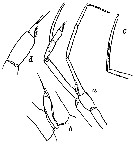 issued from : C. With in The Danish Ingolf-Expedition, Copepoda I, 1915, III, 4. [p.196, Text-fig. 61]. As Scaphocalanus obtusifrons. Male: a, P5; b, endopod of right P5; c, exopodal segment 3 of right P5; d, endopod of left P5.
|
 issued from : H.B. Owre & M. Foyo in Fauna Caribaea, 1, Crustacea, 1: Copepoda. Copepods of the Florida Current. [p.68, Figs.437, 438]. As Amallothrix emarginata. Female: 437, habitus (lateral); 438, rostrum.
|
 issued from : H.B. Owre & M. Foyo in Fauna Caribaea, 1, Crustacea, 1: Copepoda. Copepods of the Florida Current. [p.68, Fig.441]. As Amallothrix emargionata. Female: 441, P5. Nota: P5 with 2 segments.
|
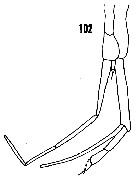 issued from : H.B. Owre & M. Foyo in Fauna Caribaea, 1, Crustacea, 1: Copepoda. Copepods of the Florida Current. [p.24, Fig.102]. As Amallothrix emarginata. Male: 102, P5.
|
 Issued from : C. Séret in Thesis 3ème Cycle, UPMC, Paris 6. [Pl. XXXIII, Figs.202-206]. As Amallothrix polaris. Female (from off Kerguelen Is.): 202-203, habitus (dorsal and lateral, respectively); 204, rostrum (ventral view); 205, last two thoracic sefments and urosome (lateral); 206, P5.
|
 issued from : O. Tanaka in Publ. Seto Mar. Biol. Lab., 1962, X (1). [p.68]. Female (from Izu region): Proportional lengths of segments of A1 left side. A1 23-segmented on the left sie; 22-segmented on the right side.
| | | | | Compl. Ref.: | | | Kuriyama & Nishida, 2006 (p.299: Tab.II; fig.7, 10, vertical distribution). | | | | NZ: | 18 + 1 doubtful | | |
|
Distribution map of Pseudoamallothrix emarginata by geographical zones
|
| | | | | | | | | | | |  issued from : W. Vervoort in B.A.N.Z. Antarctic Reseach Expedition, Reports - Ser. B, Vol. III, 1957 [Fig.96]. As Scolecithricella (Amallothrix) polaris. issued from : W. Vervoort in B.A.N.Z. Antarctic Reseach Expedition, Reports - Ser. B, Vol. III, 1957 [Fig.96]. As Scolecithricella (Amallothrix) polaris.
Chart showing the geographical distribution (white circle) in the seas surrounding the Antarctic continent.
Nota: In this chart the area frequented by whaling vessels has been hatched. The Antarctic circle (66°.5 S) has been drawn as a broken line. The numbers I to VI refer to the sectors into which the Antarctic seas are divided according to Mackintosh (1942) (after Vervoort, 1951). |
 Issued from : C. Séret in Thesis 3ème Cycle, UPMC, Paris 6. 1979, Annexe. [p.39]. Issued from : C. Séret in Thesis 3ème Cycle, UPMC, Paris 6. 1979, Annexe. [p.39].
Geographical occurrences of Amallothrix polaris (= in the Indian Ocean and Antarctic zone. [after publications from: Brady, 1883, 1918; Thompson, 1900; Wolfenden, 1908, 1911; With , 1915; Rosendorn, 1917; Farran, 1929; Sewell, 1929, 1947; Brady & Gunther, 1935; Steuer, 1929, 1392, 1933; Ommaney, 1936; Vervoort, 1957; Tanaka, 1960; Brodsky, 1964; Seno, 1966; Andrews, 1966; Grice & Hulsemann, 1967; Seno, 1966; Frost & Fleminger, 1968; Voronina, 1970; Zverva, 1972]. |
| | | | Loc: | | | Antarct. (Weddell Sea, SW & SE Atlant., Indian, SW & SE Pacif., Croker Passage), South Georgia, sub-Antarct. (Indian, SW & SE Pacif.), South Africa (E), Namibia, ? off SW Ascension Is., G. of Guinea, off Mauritania, Canary Is., off Madeira, Portugal, off W Cabo Finisterre, Bay of Biscay, Azores, Caribbean Sea, G. of Mexico, Florida, off Bermuda: Station "S" (32°10'N, 64°30'W), Sargasso Sea, off E & SE Cape Cod, G. of Maine, off E Nova Scotia, S Davis Strait, Iceland, Faroe Is., off W Ireland, Arabian Sea, off SW Sri Lanka, Natal, Indian, Indonesia-Malaysia, Philippines, China Seas (East China Sea), Taiwan (SW), Japan, Sagami Bay, ? off Hokkaido, N Pacif., Okhotsk Sea, Bering Sea, off S Aleutian Is., ? Station “P”, off British Columbia, Pacif. (W equatorial), Pacif. central (subarct.), New Zealand, Hawaii, Guaymas Basin, ? California, ? G. of California, Chile (N) | | | | N: | 65 | | | | Lg.: | | | (1) F: 4,2; M: 4; (5) F: 4,3; (7) F: 4,4; M: 3,84; (9) F: 4,5-3,95; M: 3,9-3,8; (10) F: 4-3,5; (11) F: 4,3; (16) F: 4,73-4,15; M: 4-3,95; (25) F: 4,41-4,28; (35) F: 4,38; (38) F: 3,96; (58) F: 4,3; (117) F: 4,25; M: 3,94; (199) F: 4,33-4,03; (208) F: 4,2; (246) F: 4,2-4,18; (432) F: 2,5; (523) F: 4,8-3,64; (1000) F: 4,2 ± 0,3 ; M: 4,1 ±0,2; {F: 2,50-4,80; M: 3,80-4,13} | | | | Rem.: | Meso-bathypelagic. Sargasso Sea: 500-2000 m (Deevey & Brooks, 1977, station "S"); 2000-1000 m (Harding, 1974).
Distributional range (m) from Roe (1972) Day: 600-950, Night: 660-960; from Grice & Hulsemann (1965): 1500-2000 (in Kuriyama & Nishida, 2006).
See remarks to P. hadrosoma and P. obtusifrons.
For Vervoort (1957, p.106) the male describes by Wolfenden (1911, p.253, Fig.31 a, d) belongs to Scaphocalanus (probably Scaphocalanus brevicornis).
After Tanaka (1962, p.69) Scolecithricella emarginata (Farran) and Amallothrix obtusifrons Sars resemble each other so closely that a considerable confusion arisen. A. obtusifrons is larger in size, and is rounded on the posterolateral margin of the last thoracic segment. In P5 the inner marginal spine arises much apart from the apical spine in obtusifrons, whereas, it arises very near to the apical in emarginata. On comparing the appendages of the male from Suruga Bay, with those of the female specimen of S. emarginata from Izu region, and with the male P5 of A. obtusifrons Sars, the author regards the male specimen as S. emarginata (= Pseudoamallothrix emarginata according to Vyshkvartzeva, 1999-2000). | | | Last update : 19/01/2021 | |
|
|
 Any use of this site for a publication will be mentioned with the following reference : Any use of this site for a publication will be mentioned with the following reference :
Razouls C., Desreumaux N., Kouwenberg J. and de Bovée F., 2005-2025. - Biodiversity of Marine Planktonic Copepods (morphology, geographical distribution and biological data). Sorbonne University, CNRS. Available at http://copepodes.obs-banyuls.fr/en [Accessed October 23, 2025] © copyright 2005-2025 Sorbonne University, CNRS
|
|
 |
 |



























